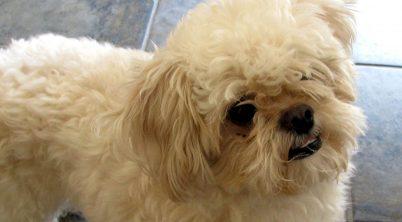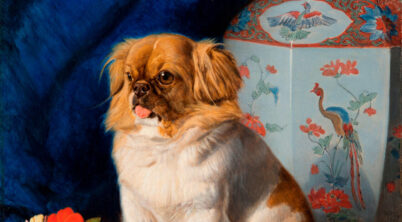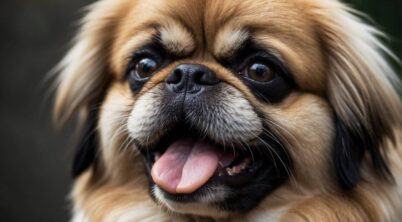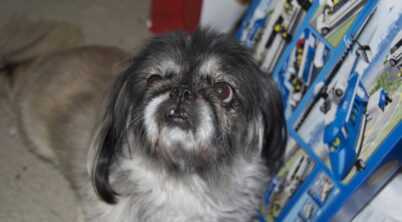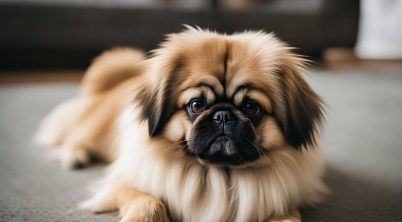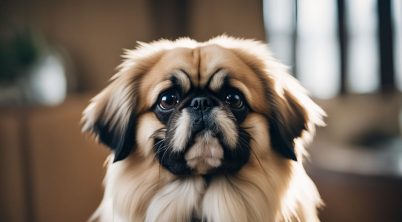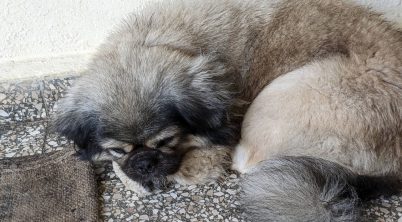The Pekingese, a toy breed with a rich history hailing from ancient China, is renowned for its luxurious fur that creates an impressive mane around its neck and shoulders. This breed, often referred to as the “lion dog” due to its strong resemblance to Chinese guardian lions, bears a coat that enhances its dignified and regal appearance. Traditionally, the Pekingese boasts a double coat consisting of a thick undercoat and a longer, straight topcoat which come in various colors and markings.
Despite the breed’s distinctive long coat, discussions around “Pekingese no fur” could emerge from situations such as grooming styles or health-related conditions that may cause fur loss. The thick coat of the Pekingese requires regular grooming to maintain its condition and to prevent matting. In hotter climates or seasons, some Pekingese may have their fur trimmed or clipped to alleviate discomfort from the heat. Regular grooming also helps manage shedding, as the breed is known to shed considerably.
Moreover, Pekingese owners need to be vigilant about their dogs’ skin and coat health. Certain conditions can lead to fur loss, making understanding the care requirements of this breed essential for maintaining their characteristic appearance. The Pekingese’s unique physical attributes, including their short face, require owners to be mindful of their pet’s respiratory health and dietary needs to prevent issues such as gassiness which can affect overall wellbeing, including coat condition.
Breed Characteristics and Appearance
The Pekingese is a toy breed with a lion-like mane and a distinct appearance that has been associated with Chinese royalty for centuries. Its features include a stocky body, a unique facial structure, and a luxuriant double coat that comes in an array of colors.
Physical Attributes
The Pekingese breed is known for its compact size, which is typically 6 to 9 inches in height and up to 14 pounds in weight. They have a short, broad head with a flat face and large, expressive eyes. This breed’s body is characterized by its stockiness, making it appear sturdy and solid despite its small stature.
- Size: 6-9 inches (height), up to 14 pounds (weight)
- Build: Compact, stocky
Coat and Color Variations
One of the most striking features of the Pekingese is its double coat. The outer layer consists of long, coarse hair, while the undercoat is soft and dense. This breed’s coat is designed to protect them in various weather conditions, and its thickness can make the Pekingese resemble a tiny lion.
- Coat Type: Long, coarse outer coat with a soft, thick undercoat
- Mane: Pronounced, resembling that of a lion
Regarding color variations, the Pekingese can exhibit a wide range, including but not limited to red, tan, gold, black, and white. The mane often presents itself in a lighter shade, contributing to the lion-like appearance for which the breed is known.
- Coat Colors: Red, tan, gold, black, white
- Patterns: Solid or with a mix of colors; acceptable markings include a black mask and parti-colors
Grooming and Care
Proper grooming is pivotal for maintaining the exquisite coat of a Pekingese and supporting their overall health. This section provides detailed insights into the specifics of coat maintenance and health considerations to ensure the Pekingese thrives.
Maintaining the Coat
Pekingese dogs boast a long, luxurious fur that demands regular attention. Daily brushing is essential to prevent tangles and mats, and owners should use a high-quality brush suitable for long-haired breeds. Combining frequent brushing with periodic trimming keeps their coat manageable and aesthetically pleasing.
- Bathing should be done with care, usually every few weeks, using a dog-specific shampoo to maintain the fur’s natural oils.
- Eyes and ears must be cleaned during grooming sessions to prevent infections, taking special care to remove any debris gently.
Health Considerations
Grooming is not only for appearance but is closely linked to the Pekingese’s health.
- Teeth: Regular brushing with canine toothpaste can prevent dental issues, thus enhancing overall health.
- Skin: A clean coat prevents skin irritations and infections. Pay attention to the Pekingese’s unique facial structure, cleaning any folds thoroughly.
While Pekingese are known for being high-maintenance in terms of grooming, investing time into these practices can thwart a host of health problems and ensure a clean, happy dog.
Diet and Nutrition
Proper diet and nutrition are critical for a Pekingese’s health. They are small dogs, and their diet should be formulated to meet the needs of their size and energy levels. A balanced diet helps maintain their weight within a healthy range, which is vital since obesity can pose health risks.
Daily Food Intake
- Puppies (Under 1 year): Feed 3 times
Common Health Issues
The Pekingese breed, with its distinctive flat face and luxurious fur, is known for several breed-specific health issues. It’s essential for Pekingese owners to be aware of these potential concerns to ensure proper care and preventative measures.
Eyes: The prominent eyes of a Pekingese can be prone to issues such as corneal ulcers, dry eye, and cherry eye. The breed’s eye positioning makes them susceptible to injuries, requiring diligent monitoring for signs of distress or damage.
Breathing: Pekingese dogs have a brachycephalic skull shape, meaning they often have shorter nasal passages and a compacted upper respiratory system. This anatomical feature may lead to breathing difficulties, which can exacerbate problems like snoring or lead to more serious respiratory conditions.
Skin and Grooming: Skin problems are not uncommon in Pekingese due to a variety of factors, including parasites, allergies, and infections. Regular grooming is vital as their thick coats can hide issues. Symptoms to look for include excessive scratching, hair loss, scabbing, and skin redness.
- Teeth: Dental health in Pekingese should also be a priority as they are inclined to periodontal diseases. Regular dental check-ups and cleanings are advised to prevent tooth loss and other oral health issues.
Owners should consider these health problems when caring for their Pekingese and consult with a veterinarian for routine health assessments. Early detection and management of these conditions are essential for the well-being of this cherished breed.
Living with a Pekingese
When welcoming a Pekingese into a household, owners must consider the breed’s unique temperament and grooming needs, ensuring a harmonious home for both pet and human.
Household Adaptations
A Pekingese, though small in stature, requires specific household adjustments to thrive. As a toy breed, their space needs are modest, but attention should be paid to grooming. Daily brushing is essential to prevent mats and tangles in their long, thick fur. They do not adapt well to extreme temperatures, so maintaining a comfortable climate indoors is important.
Owners should also provide:
- A variety of toys to keep them entertained.
- A sleeping area that feels safe and secure.
- Regular clean-up routines, as hair shedding is considerable.
As watchdogs, Pekingeses are naturally alert and may bark to announce visitors or unusual activity. This instinct can be managed with proper training and a calm household environment.
Socialization and Companionship
The Pekingese temperament leans toward independence, but they are also affectionate companions who enjoy being part of the family. Early socialization is crucial to help them become well-adjusted to people and other pets. They tend to form strong bonds with their owners and can make excellent lap dogs.
However, despite their affectionate nature, they are not overly demanding of attention and can entertain themselves with toys. Owners should balance interactive playtime with periods of independence, allowing the Pekingese to enjoy solitude without feeling neglected.
Given their stature as a toy breed, Pekingeses require minimal exercise, making them suitable for small living spaces. However, they benefit from short but regular walks to ensure physical and mental stimulation.

